Yes, a 3-gallon air compressor can run a brad nailer. Brad nailers are pneumatic tools that require relatively low air pressure and volume compared to larger tools like framing nailers or spray guns.
The 3-gallon tank should provide enough compressed air to operate a brad nailer effectively for most tasks, such as trim work and light carpentry. However, keep in mind that the compressor’s duty cycle and recovery time may affect continuous usage, so occasional pauses for the compressor to refill may be necessary during extended use.
Let’s dive deeper to uncover the specifics and ensure your next DIY project goes off without a hitch.
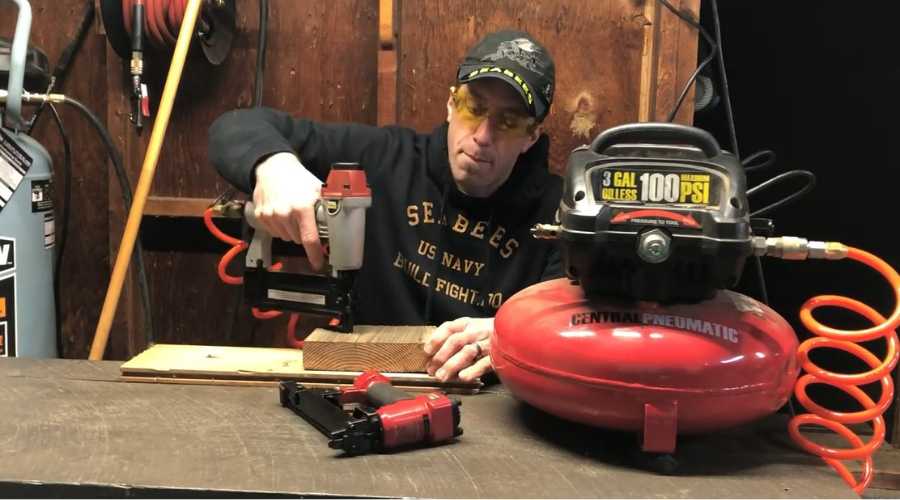
Understanding The Basics Features Of An Air Compressor:
A 3-gallon air compressor is a handy tool to have around the house, especially if you’re into DIY projects or woodworking. But before you start using a brad nailer with it, you need to make sure that your air compressor has the right features to power the tool.
Here are some key features you should consider before using a brad nailer with a 3-gallon air compressor:
CFM And PSI
The CFM (cubic feet per minute) and PSI (pounds per square inch) are important factors to consider when using a 3-gallon air compressor with a brad nailer.
CFM measures the volume of air that the compressor can deliver, while PSI measures the pressure.
Ideally, your brad nailer should have a CFM of at least 2.0 and a PSI of at least 70-90 to function optimally.
Horsepower (Hp)
The horsepower (Hp) of an air compressor is an indication of its power and performance. A higher Hp means that the compressor can deliver more power to your tools.
A 3-gallon air compressor should have at least 1 Hp to run a brad nailer efficiently.
Noise Levels
When choosing a 3-gallon air compressor, it’s essential to consider the noise levels. Compressors can be quite loud, so if you’re working in a confined space or a residential neighborhood, you might want to opt for a quieter model.
Look for compressors that have a noise level of around 60 decibels or less.
Tank Size
The tank size is another critical factor to consider when buying a 3-gallon air compressor. If you plan on using your brad nailer for extended periods, you’ll want a compressor with a larger tank.
A 3-gallon tank may be sufficient for short bursts of work, but if you plan on using your brad nailer for extended periods, you may want to consider a compressor with a larger tank.
Portable Or Stationary
Another thing to consider is whether you want a portable or stationary 3-gallon air compressor. If you plan on moving your compressor around frequently, a portable model is a better option.
However, if you have a dedicated workshop or workspace, a stationary compressor may be a better choice.
Electric Or Gasoline Powered
Finally, consider whether you want an electric or gasoline-powered 3-gallon air compressor. Electric compressors are more suited to indoor use, whereas gasoline-powered compressors are ideal for outdoor use and more heavy-duty tasks.
Before using a brad nailer with a 3-gallon air compressor, you need to ensure your compressor has the right features.
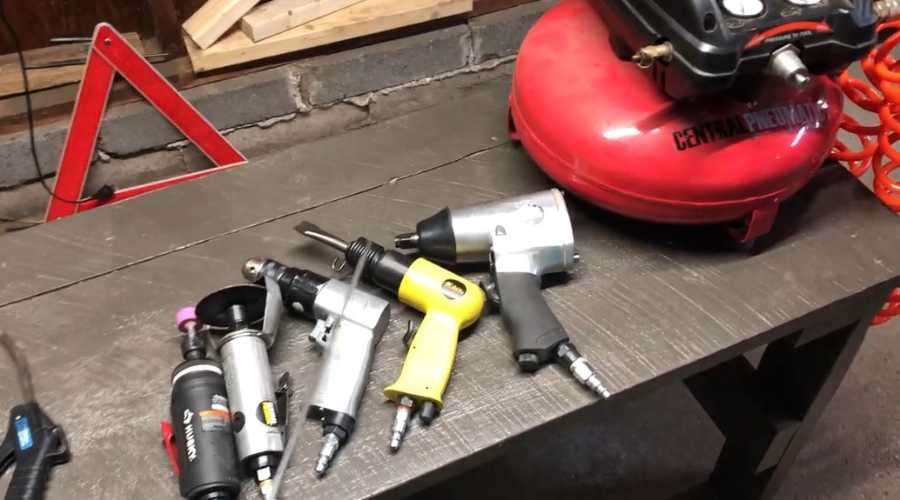
What Size Air Compressor For Brad Nailer?
The ideal size of an air compressor for a brad nailer is generally in the range of 2 to 6 gallons. A 2 to 6-gallon air compressor provides sufficient air pressure and volume to power a brad nailer effectively. Brad nailers are low-demand pneumatic tools, so a smaller compressor can handle them without any issues.
However, if you plan to use other air tools alongside your brad nailer, opt for a larger compressor with a higher gallon capacity to ensure it can meet the combined air requirements of all your tools.
Always refer to the tool manufacturer’s recommendations for the specific compressor size required for your tasks.

Can A 3 Gallon Air Compressor Run A Brad Nailer?
Are you planning to use a brad nailer but wondering if your 3-gallon air compressor is sufficient to power it? Let’s find out!
Determining The Required CFM And PSI For A Brad Nailer
To determine the required CFM (cubic feet per minute) and PSI (pounds per square inch) for a brad nailer, consider the following factors:
- CFM: The airflow required to operate the tool continuously without overheating. A brad nailer typically requires 0.3 – 1.5 CFM.
- PSI: The air pressure needed to drive brads into the work surface. A brad nailer usually requires 70 – 120 PSI.
Comparing The Required CFM And PSI To The Capability Of A 3-Gallon Air Compressor
A Typical 3-Gallon Air Compressor Delivers
- CFM: 0.5 cfm at 90 psi and 0.7 cfm at 40 psi
- PSI: Up to 100 psi
Thus, a 3-gallon air compressor can run a brad nailer, but the performance may vary depending on the specific requirements of the tool and the project.
Factors That Affect The Performance Of A 3-Gallon Air Compressor
Various factors can affect the ability of a 3-gallon air compressor to power a brad nailer, such as:
- Length and diameter of the air hose
- Ambient temperature and humidity
- Cleanliness and maintenance of the air compressor
- Type and quality of the brads and the work surface
Tips To Optimize The Performance Of A 3-Gallon Air Compressor When Using A Brad Nailer
Here are some tips to maximize the efficiency and effectiveness of your 3-gallon air compressor when using a brad nailer:
- Use a shorter and wider air hose to minimize pressure loss
- Keep the air compressor in a cool, dry, and clean environment
- Service and clean the air compressor regularly to prevent clogs and malfunctions
- Use high-quality brads and ensure the work surface is free from debris and moisture
In summary, we can say that a 3-gallon air compressor can operate a brad nailer to some extent, but it’s essential to consider the required CFM and PSI for the specific tool and project. Optimize the performance of your air compressor by following the tips mentioned above.
Happy nailing!
Is A 3 Gallon Air Compressor Good For Nail Gun?
Yes, a 3-gallon air compressor is generally suitable for a nail gun. Nail guns, especially brad nailers and finish nailers, typically require lower air pressure and volume compared to larger pneumatic tools.
A 3-gallon compressor can provide enough air to power a nail gun effectively for various woodworking and construction tasks. However, it’s important to consider the compressor’s duty cycle and recovery time, as continuous or heavy use may require brief pauses for the compressor to refill.
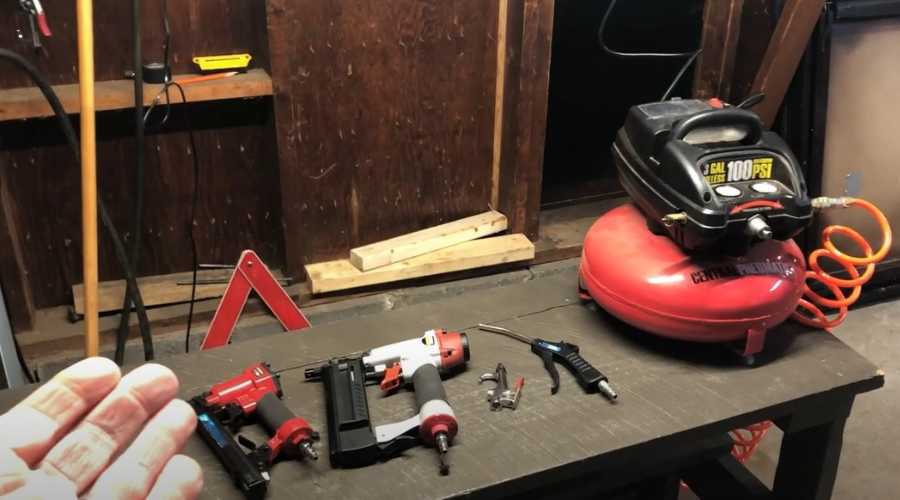
Will A 3 Gallon Air Compressor Run A Framing Nailer?
No, a 3-gallon air compressor is typically not suitable for running a framing nailer. Framing nailers require a much higher volume of compressed air (usually 2.2 cfm at 90 psi) compared to smaller nail guns like brad nailers or finish nailers.
They are designed for heavy-duty tasks and need a larger compressor with a higher gallon capacity, typically 6 gallons or more, to operate effectively.
Attempting to use a 3-gallon compressor with a framing nailer may result in insufficient air supply and inconsistent performance.
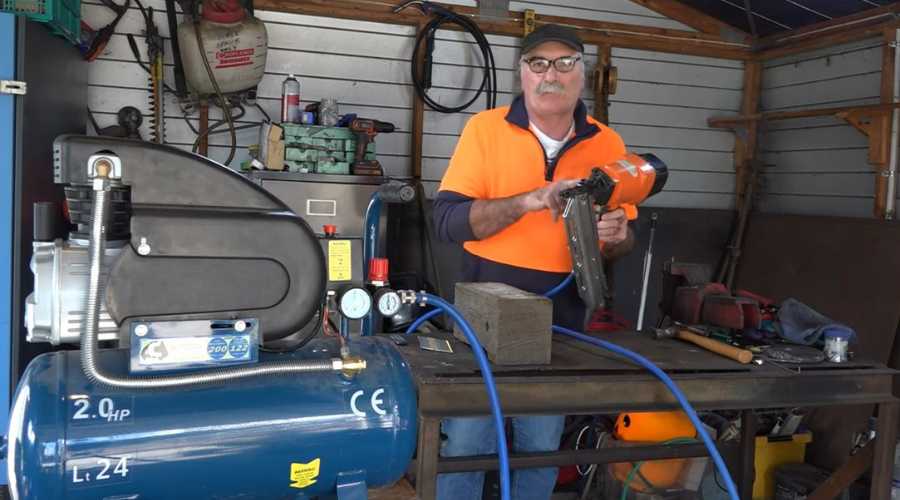
Will A 3 Gallon Air Compressor Run An Impact Wrench?
A 3-gallon air compressor may not be suitable for running an impact wrench effectively. Impact wrenches typically require a higher air volume and pressure to deliver the torque needed for tasks like automotive work or heavy-duty fastening.
A larger compressor with a higher gallon capacity and greater horsepower is usually recommended for powering impact wrenches.
While a 3-gallon compressor can technically run a small or low-torque impact wrench for light tasks, it may struggle with larger, more demanding wrenches and could lead to reduced performance.
Always check the manufacturer’s recommendations for the specific impact wrench you plan to use to ensure it matches your compressor’s capabilities.
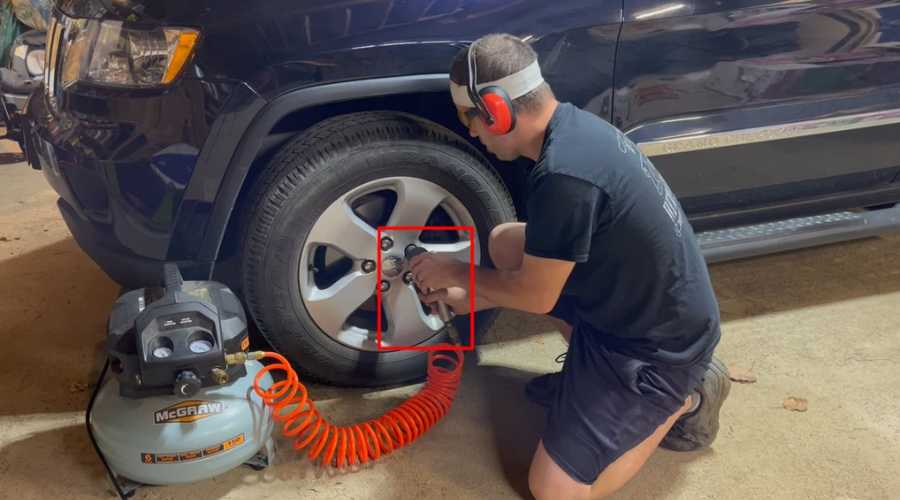
What Size Air Compressor For Roofing Nailer?
For a roofing nailer, it’s typically recommended to use an air compressor with a larger tank size, preferably in the range of 4 to 6 gallons or more. Roofing nailers require a steady and consistent air supply because they drive numerous nails in succession, especially for roofing projects.
A larger compressor can maintain the necessary air pressure and volume without frequent pauses to refill, ensuring efficient and smooth operation. It’s essential to choose a compressor that can meet the air demand of your roofing nailer to avoid disruptions during your roofing tasks.
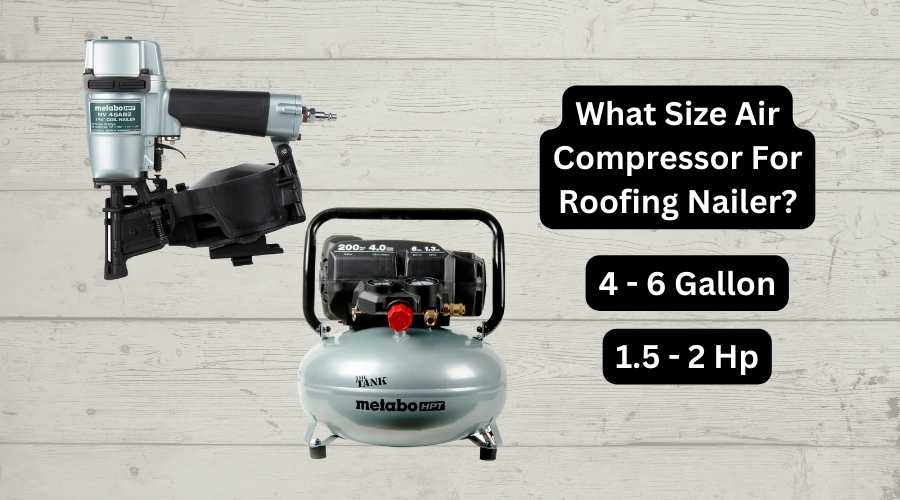
A Comprehensive Table Comparing Air Compressor Requirements For Various Tools
Here is a detailed table comparing air compressor needs for various tools. We believe it will assist you in understanding the air volume and tank size for various pneumatic tools, allowing you to make an informed decision when purchasing an air compressor.
Keep in mind that specific requirements can vary depending on the brand and model of the tool, so always refer to the manufacturer’s recommendations for precise details.
| Tool | Minimum Tank Size (Gallons) | Minimum CFM (Cubic Feet per Minute) | Minimum HP (Horsepower) |
|---|---|---|---|
| Framing Nailer | 4-6 | 2-4 | 1.5-2 |
| Brad Nailer | 2-3 | 0.5-1 | 1-1.5 |
| Finish Nailer | 2-3 | 1-2 | 1-1.5 |
| Roofing Nailer | 4-6 | 2-4 | 1.5-2 |
| Impact Wrench 3/8″ | 4-6 | 2-4 | 1.5-2 |
| Impact Wrench 1/2″ | 6-8 | 4-7 | 2-3 |
| Drill | 4-6 | 3-5 | 1.5-2 |
| Sander | 6-10 | 6-10 | 3-5 |
| Paint Sprayer | 6-10 | 6-12 | 3-5 |
| Air Brush | 1-3 | 0.5-1 | 0.5-1 |
| Ratchet 1/4” | 2-3 | 2-3 | 1-1.5 |
| Ratchet 3/8” | 3-4 | 3-4 | 1.5-2 |
| Die Grinder | 4-6 | 4-7 | 2-3 |
| Air Inflator | 2-3 | 2-4 | 1-1.5 |
Please note that these are general guidelines, and actual requirements may vary based on factors like tool efficiency, operating pressure, and the specific tasks you’re performing. It’s essential to choose a compressor that can meet the demands of the most air-hungry tool you plan to use to ensure optimal performance across all your pneumatic tools.
Alternatives To A 3-Gallon Air Compressor:
A 3-gallon air compressor is lightweight, compact, and a popular tool used by DIYers and professionals alike. One of the most common questions asked by those interested in purchasing a 3-gallon air compressor is whether it can run a brad nailer.
The answer is yes, it can.
However, there are some things you need to keep in mind, such as the size of the brad nailer and the psi requirement.
Although a 3-gallon air compressor is a great tool for small projects and portable enough to move from job to job, it’s not always sufficient for larger tasks.
Here are the alternative options of a 3 gallon air compressor:
6 Gallon Air Compressor:
This compressor provides a bit more power, allowing you to operate larger tools like a framing nailer or a drill driver. It’s still relatively portable, making it great for most job sites.
Generally, brad nailers require a minimum of 0.5 to 1.0 CFM (cubic feet per minute) at 90 PSI (pounds per square inch) to operate effectively. A 6 gallon compressor typically produces around 2.6 CFM at 90 PSI, which should be sufficient for most brad nailers.
In addition to run a brad nailer, you can use a 6 gallon compressor to run other small pneumatic tools, such as tire inflators, airbrush, light-duty paint sprayers, and even can run a small impact wrench.
10 Gallon Air Compressor:
If you’re planning to run a small wood shop and need more power, a 10-gallon air compressor would be the better option. With a 10 gallon compressor, you can run multiple brad nailer without any disruption.
In general, a 10 gallon air compressor with a 2-3 horsepower motor and a maximum PSI of around 125 should provide a CFM output of around 4 – 5. Whereas, to run a brad nailer we need only 0.5 CFM.
As a result, with a 10 gallon air compressor, you can handle multiple air tools simultaneously. A 10 gallon air compressor can handle larger tools, such as finish nailers, framing nailers, impact wrench, air ratchets, paint sprayers, etc., effortlessly.
20 Gallon Air Compressor:
The 20 gallon air compressor is an essential tool in any professional’s arsenal. It provides a powerful and reliable source of compressed air, which can be used for a variety of tasks such as powering pneumatic tools, inflating tires, and cleaning equipment.
With a tank capacity of 20 gallons, this air compressor can sustain high levels of air pressure for extended periods of time, ensuring that you do not have to pause your work to refill it.
The compressor is also designed with safety in mind, featuring an automatic shut-off valve that prevents it from overheating and causing damage. Its durable construction and efficient operation make it a must-have for any job site or workshop.
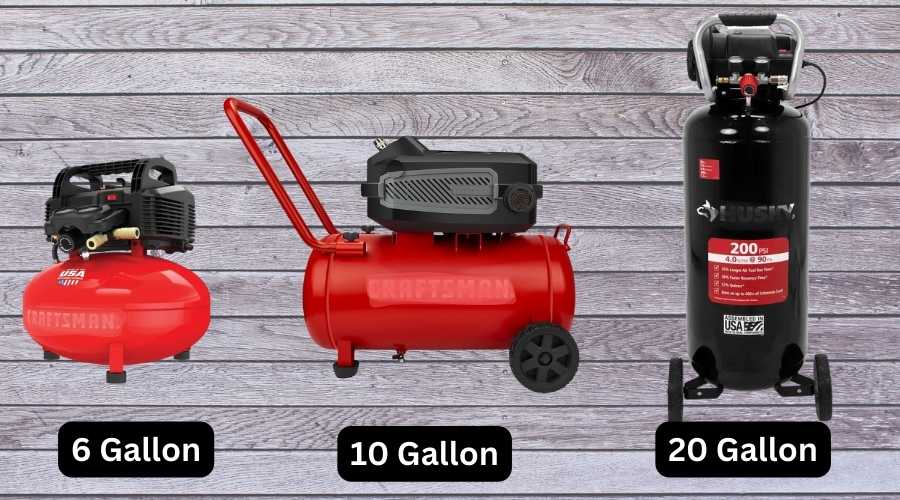
Tank Sizes And Horsepower Options
There are a multitude of tank sizes and horsepower options to choose from when it comes to air compressors. Here are a few options to consider:
- Tank sizes: Smaller tanks, such as 2 to 4-gallons, are perfect for small projects and portability. Medium-sized tanks, such as 6 to 20-gallons, can handle most tasks. Larger tanks, such as 30 gallons or more, are best for industrial work, which requires continuous use of pneumatic tools.
- Horsepower: The horsepower you need depends on the type of work you’re doing. For smaller tasks, a compressor with 1 to 2 horsepower should suffice. For larger tasks, you’ll want to look for a compressor with 3 to 5 horsepower.
Pros And Cons Of Upgrading To A Larger Air Compressor
Before you make the leap to upgrade, it’s essential to consider the pros and cons of investing in a larger air compressor.
Advantages
- More power: A larger air compressor can handle heavier tools and get the job done more efficiently.
- Longer life: A larger air compressor has a larger motor, which means it will have a longer lifespan.
- Quieter operation: As the compressor gets bigger, it will be quieter.
Drawbacks
- Cost: Upgrading to a larger air compressor can be expensive, especially if you plan on getting one with a higher psi or horsepower.
- Portability: A larger air compressor can be more challenging to move around, which can be problematic for those who work in different job sites.
- Space: A larger air compressor requires more space for storage.
Safety Tips When Using Air Compressors And Brad Nailers:
Potential Hazards When Operating Air Compressors And Brad Nailers
Air compressors and brad nailers, when not handled safely, can lead to severe injuries. Here are the potential hazards to consider when operating these tools:
- High-pressure air coming out of the compressor or nailer can cause punctures, deep cuts or severe skin damage.
- The noise generated when using these tools can lead to hearing loss.
- The compressed air generated by the compressor can lead to a dangerous explosion if it’s not released in case of a high-pressure build-up in the tank.
Precautions And Safety Measures To Follow
To avoid any unexpected injuries or accidents when using air compressors and brad nailers, follow these precautionary measures:
- Wear protective gear such as safety goggles, earplugs or muffs, and heavy-duty gloves.
- Do not operate the compressor without a pressure regulator.
- Only use certified air hoses and connectors.
- Make sure to inspect your tools before using them to ensure they are in good condition.
- Never point the gun at anyone or yourself.
- Always disconnect the air supply and release all the pressure before you clean or repair the nailer or compressor.
Remember to prioritize your safety when using air compressors and brad nailers. Take all necessary precautions and follow the safety measures mentioned above. With proper care, you can use these tools comfortably and safely for many years to come.
Tools You Can Run With 3-Gallon Air Compressors | What You CAN And CAN’T Use With This Machine?
Frequently Asked Questions On Will A 3 Gallon Air Compressor Run A Brad Nailer
Can A 3 Gallon Compressor Run A Brad Nailer?
Yes, but it depends on the psi and cfm requirements of the nailer.
What Is The Minimum PSI Required For A Brad Nailer?
Most brad nailers require 70-120 psi for optimal performance.
What Is The CFM Requirement For A Brad Nailer?
A brad nailer needs at least 0.5 cfm at 90 psi to operate effectively.
How Long Can A 3 Gallon Air Compressor Run A Brad Nailer?
It depends on the compressor’s cfm output and frequency of use.
Is A 3 Gallon Air Compressor Suitable For DIY Projects?
Yes, it can handle small projects like installing trim, molding, and baseboards.
Conclusion
As we’ve learned, the answer to the question “will a 3 gallon air compressor run a brad nailer” is both yes and no. While some brad nailers will work just fine with a 3 gallon air compressor, others will struggle to maintain consistent pressure.
To ensure your brad nailer works properly with your air compressor, it’s important to check the manufacturer’s recommendations and ensure they are compatible. Investing in a larger air compressor may also be necessary if you plan on using your brad nailer for prolonged periods of time or on larger projects.
Regardless of the size of your air compressor, be sure to regularly maintain and service it to maximize its lifespan and performance. By following these guidelines, you’ll be able to confidently use your brad nailer with your air compressor and tackle all of your DIY projects with ease.
Recent Posts
15 Ga vs 16 Ga Finish Nailer: Which One Is Right for Your Project?
If you're diving into the world of finish carpentry or simply trying to upgrade your home tool kit, you've probably run into the question: 15 ga vs 16 ga finish nailer—what’s the big deal? They...
Woodworking in 2025 is all about efficiency, precision, and smart technology. Whether you're a beginner or a seasoned craftsman, having the right tools can make all the difference. Here are the top 7...

